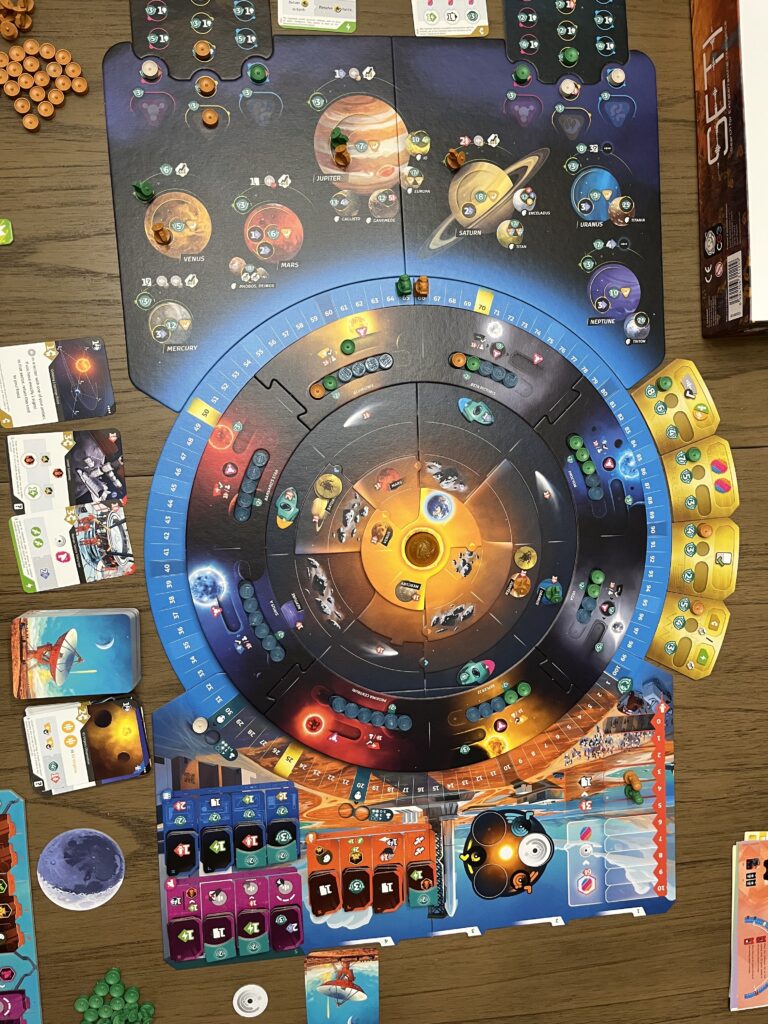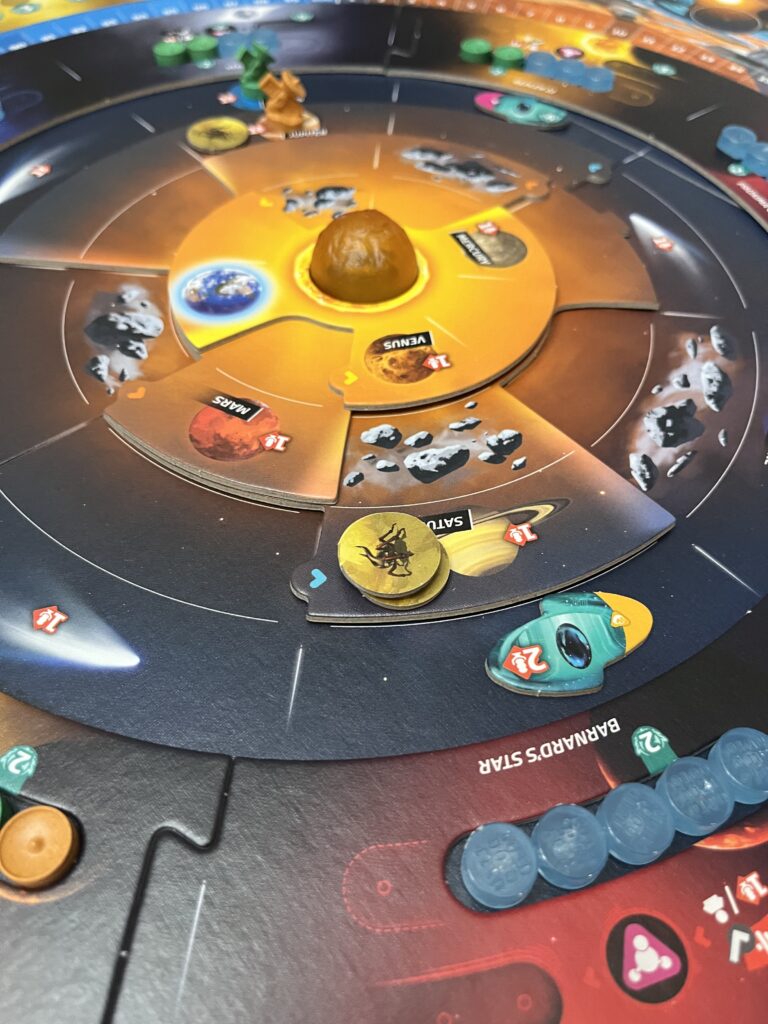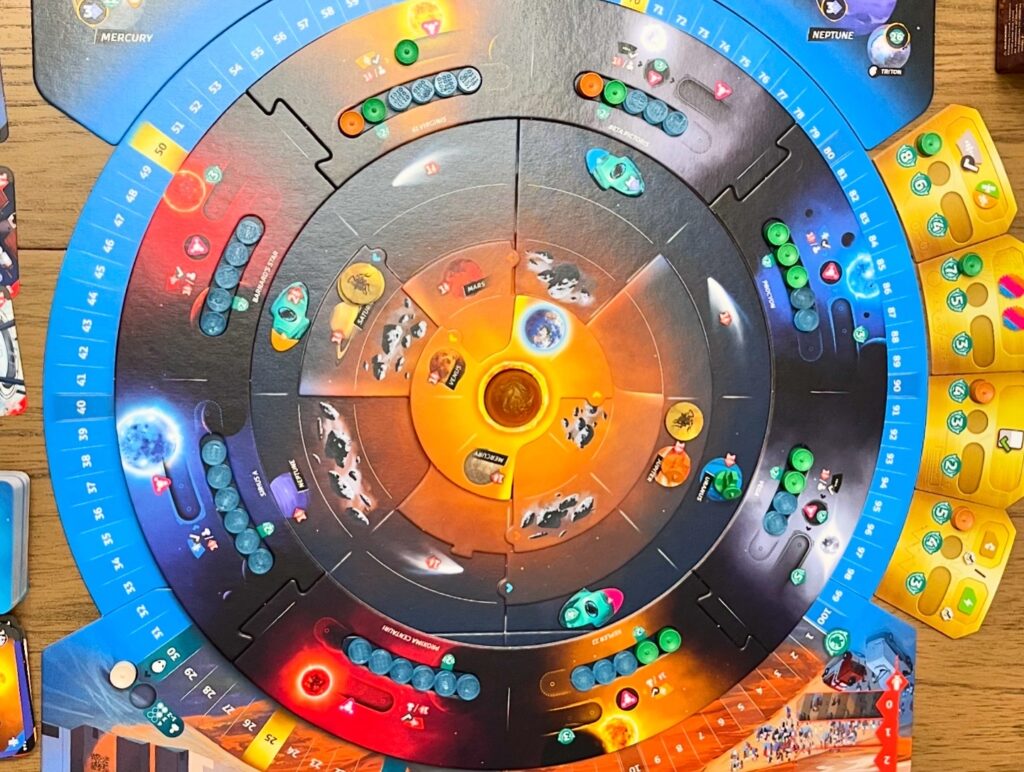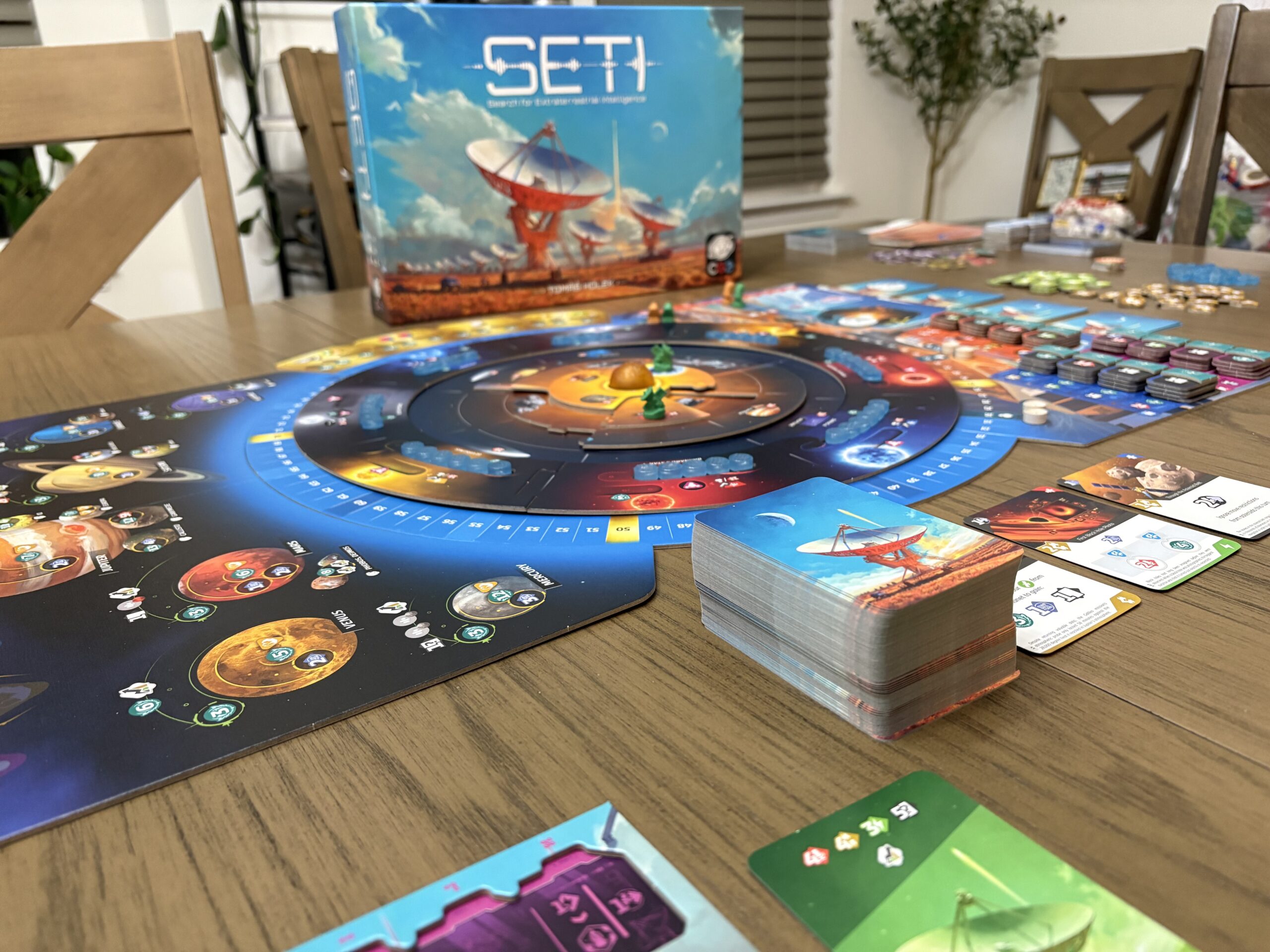Welcome to this week’s gaming post! This week I’m discussing one of the hottest games released in 2024. I also recently did an unboxing for the game that you can check out here. So without further ado, let’s jump into the review.
SETI: Search for Extraterrestrial Intelligence
- Designer: Tomáš Holek
- Publisher: Czech Games Edition
- Complexity: Medium
- Time: 40-160 Minutes
- Players: 1-4
- Main Mechanisms: Multi-use cards
SETI: Search for Extraterrestrial Intelligence is the latest in the medium-heavy euro game line from publisher Czech Games Edition (CGE). The game was also designed by Tomáš Holek who as a first-time designer released two additional games in 2024 along with SETI: Galileo Galilei and Tea Garden. I can’t speak to his other two games, but I imagine releasing three games in the same year is no small feat, particularly as a first-time designer.
As the name implies in SETI, players will be launching probes to orbit and land on planets and moons within our solar system, scan nearby stars, and analyze data to acquire traces of alien life. The game is played over five rounds, and similar to Lost Ruins of Arnak, each player will continue to take turns until all players have passed, ending the round.

Probably my favorite part of the game is the multi-use cards. I tend to enjoy games with this mechanism, but in SETI, the mechanism is ramped up to the max. Each card in the main deck of over 130 cards can be used in four different ways. First, you can pay the cost of the card (usually credits/money) to carry out whatever the action on the card specifies. The actions on the card are usually variations of the core actions, but doing so via cards is often more resource efficient. The second way is by choosing to discard the card to immediately receive the benefit in the top left. Cards can also be discarded when scanning sectors to scan in a sector matching the color in the top right of the card. Finally, cards can be tucked as income, which is gained when you tuck the card and at the beginning of each round. These multi-use cards lead to a ton of interesting and tough decisions. For example, I’ll often want to keep the card to play as main action, but if I really need the resource in the top left in that moment, that forces a hard decision. Other times, I may choose to gain a card with the purpose of tucking it as income.
Overall, this makes the game feel very tactical. You’ll receive a number of cards throughout the game, but often they are drawn randomly from the top of the deck. This means that you are forced to adapt to the cards you’re dealt. Some people may be put off by this level of randomness, but it’s one of my favorite parts about the game. You can have a general strategy or goals in mind, but to do well, you’ll have to figure out the best way to maximize your cards as they come.
This leads to my next point. While mechanically SETI is very different from Arnak, both games scratch a similar itch. In Arnak, I never feel like I have enough resources and cards to do everything I want, and I’m always having to scratch and claw to eke out a few more actions. There’s a delicate balance here where you want to be challenged, almost like putting a puzzle together, but if the game feels too punishing, it won’t be as enjoyable. I’m happy to report that SETI manages to toe this line excellently like Arnak, and this is the main reason the game keeps pulling me back in.
The alien species in SETI are also another highlight. In the base game, there are five alien species, and during setup, two are chosen randomly and placed facedown. Once all of the players have collectively acquired one of the three different colored traces, the alien species is discovered and their board is flipped face up. Each of the different species comes with their own deck of cards that can be acquired by placing further traces on the species. The alien species also come with their own small set of rules that shake up the game in interesting ways (spoiler alert: one species, the Mascamites, has you send probes to certain planets to collect samples and deliver them back to earth. Another species, the Exertians, introduces a new danger mechanic that you gain from playing end-game scoring cards from their deck and placing traces on their species board). And at the end of the game, whoever has the most danger loses one-tenth of their points. My favorite species, the Centaurians, introduce new cards that you play using energy instead of credits. When you play the card, you’ll carry out the actions on the card like normal; however, you’ll also place one of your player tokens fifteen points away from your current score. When you reach that score, you’ll receive another benefit from the card, which is often tucking the card as income, which can give you publicity or data each round instead of the normal credits, energy, or cards. I played one game with the Centaurians where I was able to keep chaining the cards together to build up a large amount of income each round. Overall, the alien species all feel unique, and if the game came out with an expansion that just added more alien species, I would buy it in a heartbeat.

The tech tiles in SETI are also very interesting and allow you to specialize in certain areas. There are four different tech tiles for each of the three main actions to improve your probes, scanning, or data actions. Also, since the first player to discover each of the twelve techs gains additional victory points, it encourages players to branch out in different paths. This, along with the alien species and cards, give the game a lot of replayability.
While still mechanically a euro game, the theme of launching probes and scanning distant stars to find alien traces is certainly unique and shines through. The production quality is also top notch with dual-layer player boards and a solar system with rotating components. SETI likely falls in the medium to medium-heavy range in terms of its complexity, but I’ve found the game to be fairly easy to teach as the core actions are relatively straightforward to understand. The game also comes with great player aids (one for each player too!), so I haven’t found myself needing to check the rulebook often during plays. Finally, the game does come with a solo mode that can be tailored to five different difficulty levels. I’ve found the solo mode to pretty easy to pilot; you flip over a card from their deck and carry out whatever action is displayed, and it does a fairly good job of simulating a human player.
Honestly, I don’t have too many negative thoughts about SETI, but there are a couple worth mentioning. First up is the game’s length. I’ve yet to play a four-player game of SETI, but even with fewer players, the game does tend to run close to the two to two-and half hour mark, and I imagine a full four-person game could potentially take three hours. One solo game I played ended up taking about two hours, and that was not including setup. The runtime doesn’t bother me too much because I enjoy the game so much, and for the most part, the game doesn’t feel like it overstays its welcome. However, the length is worth mentioning for those that are put off by longer euro games.
The bigger issue for me has to do with the scanning action in lower player counts. Since the amount of data in a sector doesn’t scale based on the number of players, I’ve found that with only two players, not that many sectors get completed during the game. Therefore, other than scanning sectors to gain data, I haven’t found going for completed sectors that viable with fewer players.

Overall, SETI is one of my favorite games that I discovered in 2024, and the multi-use cards and aliens keep me wanting to return. Does it reach the highs of Arnak? Probably not, but then again Arnak has had two excellent expansions and many more plays. However, that likely won’t keep SETI from becoming one of my go-tos.
With that, I’ll wrap up this week’s gaming highlights! I’d love to hear your thoughts on any of the games I’ve mentioned, future content, or format in the comments section below. Happy gaming!
If you liked this post and want to be notified when new content is released, then follow me on Instagram @themeepledigest.
